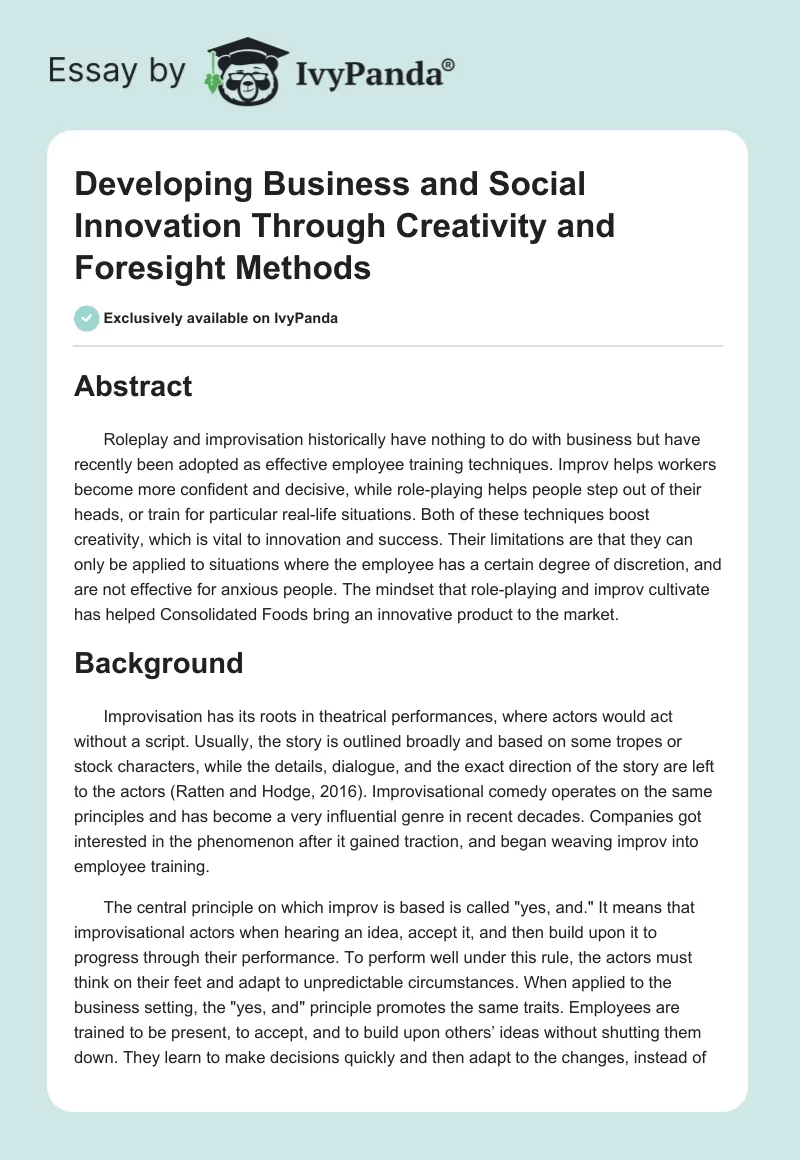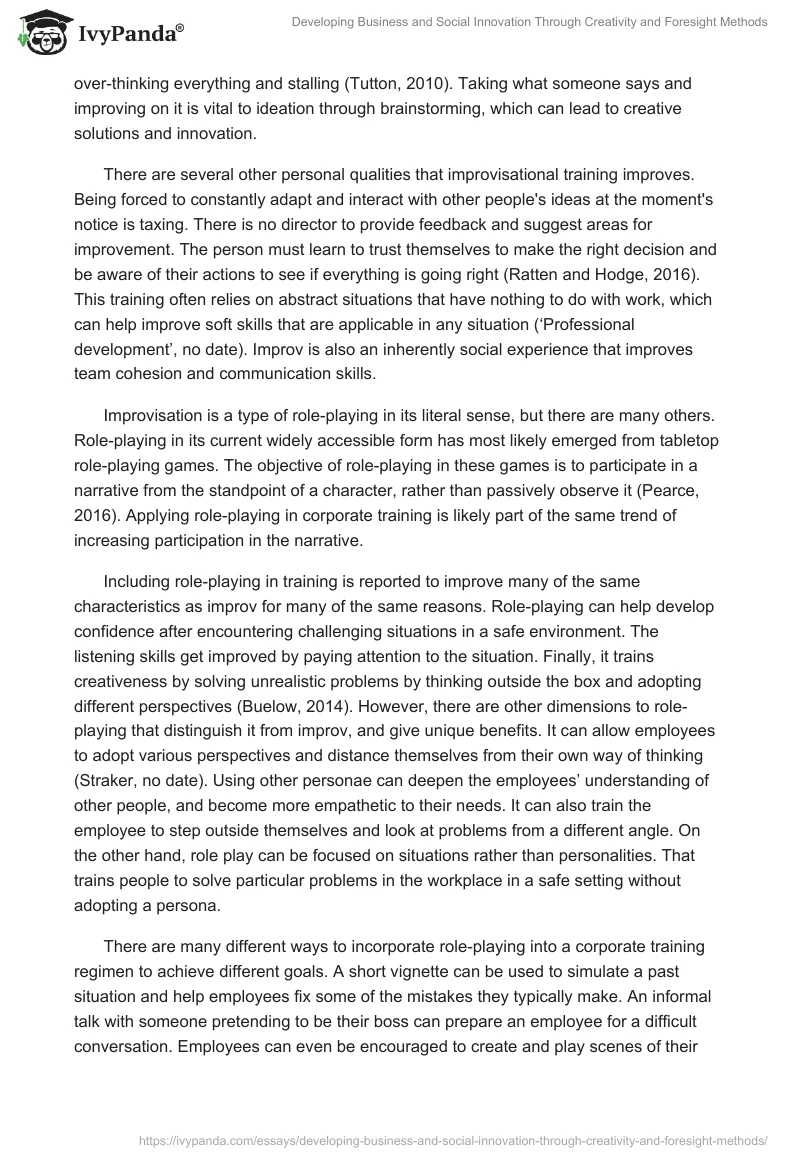Abstract
Roleplay and improvisation historically have nothing to do with business but have recently been adopted as effective employee training techniques. Improv helps workers become more confident and decisive, while role-playing helps people step out of their heads, or train for particular real-life situations. Both of these techniques boost creativity, which is vital to innovation and success. Their limitations are that they can only be applied to situations where the employee has a certain degree of discretion, and are not effective for anxious people. The mindset that role-playing and improv cultivate has helped Consolidated Foods bring an innovative product to the market.
Background
Improvisation has its roots in theatrical performances, where actors would act without a script. Usually, the story is outlined broadly and based on some tropes or stock characters, while the details, dialogue, and the exact direction of the story are left to the actors (Ratten and Hodge, 2016). Improvisational comedy operates on the same principles and has become a very influential genre in recent decades. Companies got interested in the phenomenon after it gained traction, and began weaving improv into employee training.
The central principle on which improv is based is called “yes, and.” It means that improvisational actors when hearing an idea, accept it, and then build upon it to progress through their performance. To perform well under this rule, the actors must think on their feet and adapt to unpredictable circumstances. When applied to the business setting, the “yes, and” principle promotes the same traits. Employees are trained to be present, to accept, and to build upon others’ ideas without shutting them down. They learn to make decisions quickly and then adapt to the changes, instead of over-thinking everything and stalling (Tutton, 2010). Taking what someone says and improving on it is vital to ideation through brainstorming, which can lead to creative solutions and innovation.
There are several other personal qualities that improvisational training improves. Being forced to constantly adapt and interact with other people’s ideas at the moment’s notice is taxing. There is no director to provide feedback and suggest areas for improvement. The person must learn to trust themselves to make the right decision and be aware of their actions to see if everything is going right (Ratten and Hodge, 2016). This training often relies on abstract situations that have nothing to do with work, which can help improve soft skills that are applicable in any situation (‘Professional development’, no date). Improv is also an inherently social experience that improves team cohesion and communication skills.
Improvisation is a type of role-playing in its literal sense, but there are many others. Role-playing in its current widely accessible form has most likely emerged from tabletop role-playing games. The objective of role-playing in these games is to participate in a narrative from the standpoint of a character, rather than passively observe it (Pearce, 2016). Applying role-playing in corporate training is likely part of the same trend of increasing participation in the narrative.
Including role-playing in training is reported to improve many of the same characteristics as improv for many of the same reasons. Role-playing can help develop confidence after encountering challenging situations in a safe environment. The listening skills get improved by paying attention to the situation. Finally, it trains creativeness by solving unrealistic problems by thinking outside the box and adopting different perspectives (Buelow, 2014). However, there are other dimensions to role-playing that distinguish it from improv, and give unique benefits. It can allow employees to adopt various perspectives and distance themselves from their own way of thinking (Straker, no date).
Using other personae can deepen the employees’ understanding of other people, and become more empathetic to their needs. It can also train the employee to step outside themselves and look at problems from a different angle. On the other hand, role play can be focused on situations rather than personalities. That trains people to solve particular problems in the workplace in a safe setting without adopting a persona.
There are many different ways to incorporate role-playing into a corporate training regimen to achieve different goals. A short vignette can be used to simulate a past situation and help employees fix some of the mistakes they typically make. An informal talk with someone pretending to be their boss can prepare an employee for a difficult conversation. Employees can even be encouraged to create and play scenes of their own to stimulate imagination (Silberman and Biech, 2015). Role-playing can be a powerful tool for developing creativity if applied correctly.
The most significant limitation of improvisation is that it does not train the employees for highly procedural and structured tasks. It is not useful for developing skills that rely on following strict rules and guidelines rather than creativity. Role-playing allows for developing these skills because it can be structured as active training, but, like improv, it may be too taxing for introverts and people with anxiety. Thankfully, neither improv nor role-playing costs much inherently, unless a business outsources trainers. The only investments are several hours of the workers’ time and a professional’s expertise.
Using Role Play/Improvisation for Innovation
Improv has become an effective tool for developing the individual creativity of the employees. A particular example of an improv mindset in action is the commercial success of Pop Rocks. Consolidated Foods held a brainstorming session where someone expressed the idea of “candy that could talk.” It was quickly dismissed, but one executive decision to go with it. He investigated possible ways to develop the ridiculous idea and stumbled upon carbon dioxide encased in sugar pellets. The pellets would crackle when placed in water, thus making a candy that could “talk,” which later became a popular Consolidated Foods product. The executive accepted an idea and built on it, displaying a real-life example of the “yes, and” mentality, which made Consolidated Foods a large amount of money.
Conclusions
Role-playing and improvisation can be a powerful tool for increasing creativity, confidence, and many other traits of the employees. Innovation happens when creative individuals generate ideas and then effectively implement them. One key insight that helps make that happen is the immense usefulness of the “yes, and” approach. It will help interesting ideas not get shut down immediately, among other improvements. Another key insight is that role-playing is a flexible and versatile tool, every aspect of which can be configured. A correct application of a correct version could work wonders for almost any conceivable business. Both of these methods allow people to think quicker, adapt better, and pay more attention, which should be the main takeaway.
Reference list
Buelow, J. (2014) 3 benefits of making role-play the part of training.Web.
Silberman, M. L. and Biech, E. (2015) Active training: A handbook of techniques, designs, case examples, and tips, Hoboken, NJ: John Wiley & Sons Inc.
Ratten, V., and Hodge, J. (2016) ‘So much theory, so little practice: a literature review of workplace improvisation training’, Industrial and Commercial Training, 48(3), pp. 149–155.
Kelley, T. (2005) The ten faces of innovation. Web.
Professional development (no date). Web.
Pearce, C. (2016) ‘Role-play, improvisation, and emergent authorship’, in Piekut, B and Lewis, G. E. (eds.) The Oxford handbook of critical improvisation studies, Volume 2. Oxford: Oxford University Press, pp. 445-468.
Straker, D. (no date) Role-play. Web.
Tutton, M. (2010) Why using improvisation to teach business skills is no joke. Web.


